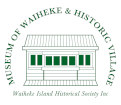
Waiheke Island Historical Society
165 Onetangi Road, RD1, Waiheke Island 1971, New Zealand
 |
Waiheke Island Historical Society165 Onetangi Road, RD1, Waiheke Island 1971, New Zealand |
[Adapted from a summary written by Pam Robinson in May 2000.]
The idea of a historical society on Waiheke Island was bandied about for several years before a dedicated group got together and held an inaugural meeting in Surfdale on 18 August 1972. Mrs Dixie Day was elected as president, Mrs Norah Robinson as secretary, Mrs B. Gould as minute secretary, and Mr Fraser as Treasurer. The annual subscription was set at 50 cents.
Suggested aims and objectives of the Waiheke Island Historical Society were set out as follows:
Subsequent amendments have added two further objectives:
These objectives have been enshrined in the Society’s Constitution.
By the time of the Society’s first Annual General Meeting on 10 August 1973, there were 41 financial members, artefacts and documents had been collected, and displays had been mounted at various functions around Waiheke. Members began to dream of establishing a building to house the expanding collection.
The Society continued to grow. Meetings were held regularly: historic outings, walks, picnics, dinners and balls. The collecting continued until finally, after a decade of fundraising, work commenced in March 1983 on a museum building situated in Anzac Reserve adjacent to the RSA. The building opened to the public on 12 December 1983, and was formally inaugurated by His Excellency Governor General David Beatty on 27 February 1984.
In 1987 an old woolshed on Onetangi Straight was gifted to the Society and a village complex was planned around it, with the proviso that the Society restore the woolshed to a safe condition. Lease of the half-hectare site was arranged with what was then the Waiheke County Council, and fundraising began again with working bees and picnics held on site. An extensive photographic record of this period can be viewed today at the Museum.
New Zealand’s 150th Anniversary year, 1990, saw three buildings join the now-refurbished woolshed on the Onetangi site. The first, Champion Cottage from Wattle Street, Oneroa, was donated with proceeds from Dixie Day’s Waiheke Pioneers book published in 1989. This cottage is furnished in the style of the 1920s-30s.
Goodwin Cottage, the second building to join the woolshed museum, was donated by family and moved from Waikare Road, Oneroa. A 1950s-style bach, Goodwin Cottage at first hosted meetings, the library and archival materials. Then for several years it was used as a caretaker’s residence; now it holds a large part of the Society’s photographic collection, as well as school, shop and domestic displays.
On 7 December 1990, the original museum building was moved from the Anzac Reserve to its present site, becoming the third building to join the woolshed that year. Now known as the Dixie and Edsell Day Memorial Cottage in honour of the Society’s most active founder and benefactor, this building houses the archives and has a meeting room on the ground floor.
The Waiheke Island Museum and Historic Village, now numbering four buildings, was officially opened by Sandra Lee on 31 December 1990, and quickly became known informally as the “woolshed museum” after its principal structure.
The Historic Village expanded again in April 1997, the Society’s twenty-fifth year, when Keane Cottage was moved from Oue Street, Oneroa. This attractive cottage was decorated in World War II style, and now houses a clinical display, domestic scenes, and a textile room in the form of a small store showing parts of the Society’s clothing collection including ladies’ “unmentionables”.
Disaster struck on 18 July 1997 when the woolshed and all its precious contents were destroyed by fire. However, thanks to quick action by the Volunteer Fire Brigade, the other museum buildings sustained only minor heat damage to the exterior. After many meetings and much discussion, the committee decided that a replacement building was necessary and a spacious fireproof modified farm building was chosen.
Building began in September 1998 and the New Woolshed building was opened to the public at Labour Weekend 1999. The official opening by John Tamahere, Maori MP for Hauraki, took place on 25 March 2000. The New Woolshed houses the main part of the collection and shows various phases of Waiheke history, from fossils to Maori artefacts to timber, mining, farming, and more recent tourist times.
In 2008, when the Waiheke police moved into their new quarters on Ocean View Road, the original 1942 detention cell was shifted to the Historic Village, forming the latest addition to our Museum.
This page last modified on 17 March 2013.